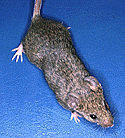|
|
| Symbol: |
EdaTa |
| Name: |
ectodysplasin-A; tabby |
| MGI ID: |
MGI:1856197 |
| Synonyms: |
Ta, Ta3, Taf, TaFa |
| Gene: |
Eda Location: ChrX:99019212-99444366 bp, + strand Genetic Position: ChrX, 43.59 cM
|
| Alliance: |
EdaTa page
|
|
EdaTa/+
Show the 2 phenotype image(s) involving this allele.
|

|
|
| Strain of Origin: |
stock including A, C57BL, CBA, and RIII
|
|
| Allele Type: |
|
Spontaneous |
| Mutation: |
|
Intragenic deletion
|
| |
|
Mutation details: This allele is characterized by an ~ 2 kb deletion: Genomic DNA was hybridized with an exon 1 probe showing a deletion including the coding region and primers for DNA flanking exon 1 failed to amplify in a PCR assay.
(J:42614, J:44605)
|
| Inheritance: |
|
Semidominant |
|
|
View phenotypes and curated references for all genotypes (concatenated display).
|
|
|
|
|
|
List all tumor models in MMHCdb carrying
EdaTa
|
|
|
|
|
This mutation arose in a strain selected for large size. Hemizygous mutant males breed satisfactorily, but homozygous mutant females are often sterile. Hemizygous mutant females are fully fertile (J:249).
Hemizygous males and homozygous females are identical in phenotype with homozygous crinkled (Edaraddcr) and downless (Edardl) mice and with homozygous or heterozygous sleek (Dlslk) mice. They are characterized by absence of guard hairs and zigzags in the coat, a bald patch behind the ear, bald tail with a few kinks near the tip, reduced aperture of the eyelids, a respiratory disorder, and a modified agouti pattern (J:249). The number of vibrissae is reduced (J:14912). The incisors may be reduced or absent, and the molars are usually smaller than normal with the third molar often absent (J:5018, J:5138). There are defects of many endocrine glands. The structures affected by the mutation all arise embryologically as downgrowths of solid epithelial cords, not by invagination with a lumen or by outgrowths from deep grooves (J:5246).
Hemizygous mutant females are most easily recognized if they are agouti, in which case they show transverse stripes of light-colored normal and dark tabby hair. They have normal incisors but may have mutant or intermediate-type molars (J:5138). A small proportion of heterozygous females may show some slight defects of some of the exocrine glands (J:5193).
In the development of the coat of homozygous and hemizygous mutant mice, hair follicle initiation begins at 17 days of gestation, 3 days later than normal, and ends 1 or 2 days after birth, several days earlier than normal. The hairs are of only one type and resemble abnormal awls (J:12100, J:5137). By use of dermal--epidermal recombination grafts of embryonic flank skin, it was shown that EdaTa acts in the epidermis in its effects on structure of the hairs (J:6041). The effect of the mutation in preventing growth of hair on the tail may be either dermal or epidermal. The mutation may act directly on hair cells or via a diffusible product (J:7450). The phenotype of EdaTa/+ females has been extensively studied because of its relevance to the X-inactivation theory of dosage compensation (J:5018, J:5238).
EdaTa and the related mutations Edaraddcr and Edardl disrupt normal development of certain epidermal derivatives, including sweat glands. Although the sensory innervation of footpad skin and the sympathetic innervation of blood vessels in the foot pad is normal in these mutants, the sympathetic fibers that normally innervate the sweat glands fail to develop (J:19910).
A candidate gene for the human familial X-linked disorder hypohidrotic ectodermal dysplasia (EDA)(OMIM 305100) has been partially cloned. Eda, a candidate for which has also been cloned, is the homologous gene in the mouse, on the basis of phenotype - hypoplasia of sweat glands, teeth, and hair - and of homologous mapping. There is high sequence identity between the cloned portions of the two genes. Known Eda mutations have been identified in the candidate mouse gene. An extracellular collagenous domain of the mouse gene, not yet identified in the EDA gene, may represent the location of mutations in 85-90% of human families (J:42614). A mouse gene Eda (ectodysplasin-A) has been proposed as the site of the tabby mutations (J:44605).
Exogenous epidermal growth factor can reverse phenotypic features of EdaTa mice, advancing the delayed opening of eyelids and eruption of incisors (J:42661) and inducing development of dermal ridges and functional sweat glands (J:42660). Expression of epidermal growth factor receptor is reduced in EDA and in EdaTa mice (J:33361).
|
| Original: |
J:249 FALCONER DS, [Total sex-linkage in the house mouse.]. Z Indukt Abstamm Vererbungsl. 1953;85(2):210-9 |
| All: |
115 reference(s) |
|
 Analysis Tools
Analysis Tools





